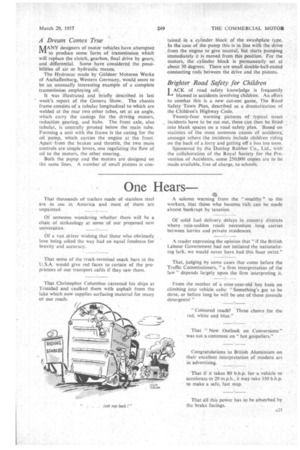Passing Comments
Page 28

Page 29

If you've noticed an error in this article please click here to report it so we can fix it.
Buses To Last 25 Years?
WHAT should be the life of a commercial vehicle? Normally, no definite answer can be given to this question for it depends largely upon the class of work on which the vehicle is engaged, the condition of the roads on which it runs and last, but not least, the attention which is given to it not only by maintenance staff, but by the driver.
So far no British manufacturer seems to have claimed any definite life and it is interesting to learn that the latest Saurer urban bus has been produced with a definite idea that it will be retained in service for at least 25 years.
This new vehicle, the type 5 D.U.P., which was shown at Geneva as a platform ready for constructing into an integral vehicle, is claimed, to include the most modern ideas for using the various materials employed in such a way as to give the lightest weight. Steel, light metals, rubber and plastics are all employed where their effect can be most valuable, and not only provide the greatest resistance to torsion but also the ability to resist impacts without causing other than local damage, which can easily be made good.
Rubber is used largely for insulation from shocks and vibration, and the external light-metal panelling is not relied upon to provide any material strength.
The main strength is in the inner skin, which is strongly riveted to the main frame, it is therefore possible rapidly to replace the external panels, which are thok most likely to suffer from damage. For this reason the immobilization of the vehicle during repair is reduced to the minimum, As it is the front part which is most exposed to impact, this is constructed almost entirely in glasspol, which is cheap and easy to replace.
The 1958 World Exhibition
A RRANGEMENTS for the 1958 World Exhibition r-1 to be held in Brussels from April 17 to October 19, 1958, are making steady progress, and more details regarding proposed exhibits were recently given at a Press conference in London.
The British section will consist of two pavilions, one arranged and paid for by the British Government, and a larger British industries pavilion which is being organized bythe Federation of British Industries through its subsidiary, British Overseas Fairs, Ltd. It is not at present intended to exhibit complete commercial vehicles or chassis.
Under the theme " Man and His Aspirations," the industrial exhibits will cover, inter alia, iron and steel, electricity, chemicals, power and energy, electric traction (including that by road) and textiles. A small cinema will show trade documentary films on behalf of industries unable to be represented. The collective exhibit being organized by the British Electrical and Allied Manufacturing Industry will be the largest single stand in this pavilion, and will cost approximately £120,000.
It is anticipated that 30m. visitors will attend the exhibition, which is being sponsored by the .Belgian Go vernmen t.
Even Better
THE reference last week to "A Successful Model" certainty indicated an improvement by Commer Avenger coaches on the vehicles previously operated by Wallace Arnold Tours, Ltd., but the gain was actually much higher. Unfortunately, a digit was dropped and the return should have read 19.8 m.p.g., making the increase per gallon 12.3 instead of 2.3.
A Dream Comes True
MANY designers of motor vehicles have attempted to produce some form of transmission which will replace the clutch, gearbox, final drive by gears, and differential. Some have considered the possibilities of air or hydraulic means.
The Hydrocar made by Gtildner Motoren Werke of Aschaffenburg, Western Germany, would seem to be an unusually interesting example of a complete transmission employing oil.
• It was illustrated and briefly described in last week's report of the Geneva Show. The chassis frame consists of a tubular longitudinal to which are welded at the rear two other tubes, set at an angle, which carry the casings for the driving motors, reduction gearing, and hubs. The front axle, also tubular, is centrally pivoted below the main tube. Forming a unit with the frame is the casing for the oil pump, which carries the engine at the front. Apart • from the brakes and throttle, the two main controls are simple levers, one regulating the flow of oil to the motors, the other steering.
Both the pump and the motors are designed on the same lines. A number of small pistons is con
tamed in a cylinder block of the swashplate type. In the case of the pump this is in line with the drive from the engine to give neutral, but starts pumping immediately it is moved from this position. For the motors, the cylinder block is permanently set at about 30 degrees. There are small double-ball-ended connecting rods between the drive and the pistons.
Brighter Road Safety for Children LACK of road safety knowlcdge is frequently blamed in accidents involving children. An effort to combat this is a new cut-out game, The Road Safety Town Plan, described as a dramatization of the Children's Highway Code;
Twenty-four warning pictures of typical street incidents have to be cut out, these can then be fitted into blank spaces on a road safety plan. Based on statistics Of the most common causes of accidents, amongst others the incidents include children riding on the back of a lorry and getting off a bus too soon.
SPonsorect by the Dunlop Rubber Co., Ltd., with ' the collaboration of the Royal Society for the Prevention of Accidents, some 250,000 copies are to be made available, free of charge, to schools.




























































































